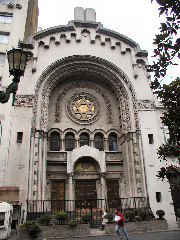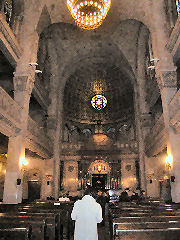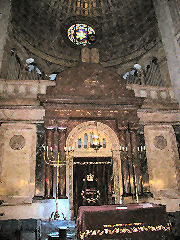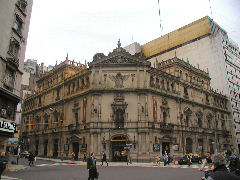Buenos Aires – Yesterday was a cool and cloudy day, looking like imminent rain at every step. A few times a drop or two fell from the sky, but they never seemed to get enough support from fellow raindrops to continue. My friend Barbara and I decided to make it a day of museum hopping. The original intent was to visit the Holocaust Museum, have lunch, and head off for a guided tour at the Xul Solar museum. But, as with many things in this city, and when you have no true agenda that must be fulfilled, things change. We started off with lunch at a nondescipt, overpriced, and mediocre coffee shop called Torre Paris on Alvear in the Centro district – I’m not going to bother to review it, just recommend against it. The Chinese restaurant we’d planned on eating at was closed for fumigation…
From there, we headed to the Museo del Holocausto, Montevideo 919. I’d stumbled across it the day before on my way to lunch, having been unaware that such a thing existed here – and in some ways, given Argentina’s history with the Jewish community, surprised as well. As with many things related to our community, security is an issue – it’s a pet peeve here – getting a chance to explore things within the Jewish sphere is quite difficult, and sometimes downright impossible. Barbara, who’s blond, and non-Jewish, has repeatedly been turned away from entering any edifice in the community here. I’ve tried a few times, but it always seemed to be on a day when I’d forgotten to bring along my passport. I’ve been told by many folks that the best approach is to get a letter from someone prominent in your Jewish community back home, preferably conservative or orthodox, and submit it to all the places you want to visit in advance, along with a copy of your passport, and then hope. Or pray.
You would think that the Fundacion Memoria del Holocausto would be eager to have people visit the museum and get a sense of what happened during WWII, and what part Argentina played and/or plays in that history. But, no. It wasn’t overly difficult to enter, but the security officer at the front, with entry door behind him closed, questioned us for several minutes, scrutinized our documents, searched our shoulder bags, and then spent another minute or two copying down detailed information from our passports into a logbook, and demanded 10 pesos apiece entry fee (which, for museums here, is higher than normal, though not expensive). Then he allowed us to enter.
In the end, I’m not sure it was worth either the time, effort, or fee – the latter at least hopefully supporting the work of the foundation. The “museum” consists of a couple of walls lined with commercial posters from the U.S. Holocaust Memorial Museum, simply framed and tacked to the walls, and all in English. In the center of the main room are a series of panels in Spanish that include photographs and information about WWII, the Nazis, and various associated information, along with historical facts and figures. A few, and only a few, of those panels have “Meanwhile, Back in Argentina” paragraphs – basically mildly critical of Argentina’s lack of response to what was going on, anti-semitism, and later complicity in allowing Nazis a safe haven. There is a clear avoidance of any outright accusations of wrong doing – evidenced by things like “Mengele was here from xxxx to xxxx, when he was found and detained for extradition to Germany to stand trial. While being detained he made his way to Paraguay and Brasil where he later died.” Good detention, that.
 From there, we decided to go to the nearby Museo Judio, attached to Buenos Aires’ oldest synagogue, C.I.R.A. (Congregacion Israelita de la Republica Argentina), Libertad 769, founded in the 1860s. If we thought the security procedures at the previous museum were strict, this one definitely exceeded it. It’s quite clear that if she hadn’t been with me, Barbara would never have been allowed in (in fact she’d tried before), and it seemed questionable as to whether I would be allowed at some moments. The security officer, while not unpleasant, was brusque and officious, demanding to know our heritage, our business in wanting to see the museum, how we knew about it, etc. I know there were a lot of problems in Argentina with the bombings in 1992 and 1994, but it seemed a bit over the top to me. In the end, he did let us in. While there’s no entry fee, donations are encouraged.
From there, we decided to go to the nearby Museo Judio, attached to Buenos Aires’ oldest synagogue, C.I.R.A. (Congregacion Israelita de la Republica Argentina), Libertad 769, founded in the 1860s. If we thought the security procedures at the previous museum were strict, this one definitely exceeded it. It’s quite clear that if she hadn’t been with me, Barbara would never have been allowed in (in fact she’d tried before), and it seemed questionable as to whether I would be allowed at some moments. The security officer, while not unpleasant, was brusque and officious, demanding to know our heritage, our business in wanting to see the museum, how we knew about it, etc. I know there were a lot of problems in Argentina with the bombings in 1992 and 1994, but it seemed a bit over the top to me. In the end, he did let us in. While there’s no entry fee, donations are encouraged.
 We happened on it at the perfect moment, about ten minutes before a guided tour in English was to begin. We sat ourselves in the small cafe and looked at the contemporary art display while waiting. We ended up striking up a conversation with a couple from Austin, Texas, who turned out to know my parents! Small world. A couple of charming women came along in a short while to take us on a tour of the synagogue’s museum, which though small, is quite fascinating, and filled with objects from the Jewish community over the last 200 years in Argentina. They also gave a great talk about the history of Jewish immigration here – up until the dictatorship in the mid 1970s, the era of the “disappeared”, there were over half a million Jews here, during that era thousands disappeared, and tens of thousands left the country fearing for their safety – there are now about 250,000 living in the country, most within the Capital.
We happened on it at the perfect moment, about ten minutes before a guided tour in English was to begin. We sat ourselves in the small cafe and looked at the contemporary art display while waiting. We ended up striking up a conversation with a couple from Austin, Texas, who turned out to know my parents! Small world. A couple of charming women came along in a short while to take us on a tour of the synagogue’s museum, which though small, is quite fascinating, and filled with objects from the Jewish community over the last 200 years in Argentina. They also gave a great talk about the history of Jewish immigration here – up until the dictatorship in the mid 1970s, the era of the “disappeared”, there were over half a million Jews here, during that era thousands disappeared, and tens of thousands left the country fearing for their safety – there are now about 250,000 living in the country, most within the Capital.
 The tour, as I said, was fascinating. The synagogue itself is stunningly impressive, built by the efforts of three fairly wealthy men who found themselves in Buenos Aires in the 1960s with nowhere organized to go pray. It’s designed in “Roman Byzantine” style, according to our guides. Very cathedral-like. Beautiful stained glass windows imported from France, lots of marble and gold, a huge pipe organ, all very impressive. The congregation is struggling, from a height of well over a thousand families at one time its membership is now only about two hundred families. Still, they run a religious school on the weekends for the children, daily services (this is a conservative movement congregation), and a bimonthly “soup kitchen” for those in need (it used to be more often, but this is all they can currently afford to offer). I did ask about attending services and was told that they do allow non-members, but recommended showing up early and bringing my passport so that my documentation could be checked before I was allowed in…
The tour, as I said, was fascinating. The synagogue itself is stunningly impressive, built by the efforts of three fairly wealthy men who found themselves in Buenos Aires in the 1960s with nowhere organized to go pray. It’s designed in “Roman Byzantine” style, according to our guides. Very cathedral-like. Beautiful stained glass windows imported from France, lots of marble and gold, a huge pipe organ, all very impressive. The congregation is struggling, from a height of well over a thousand families at one time its membership is now only about two hundred families. Still, they run a religious school on the weekends for the children, daily services (this is a conservative movement congregation), and a bimonthly “soup kitchen” for those in need (it used to be more often, but this is all they can currently afford to offer). I did ask about attending services and was told that they do allow non-members, but recommended showing up early and bringing my passport so that my documentation could be checked before I was allowed in…
 By the time the tour was over it was too late to make it to the guided tour at the Xul Solar museum, so that will be saved for another day. Instead we wandered a half block away to the Museo Nacional del Teatro, attached to the Teatro Cervantes, at Córdoba 1199. A beautiful building housing a theater where many important performances take place. There’s no entry fee, and no security procedures. The museum is fairly small, and consists mostly of walls covered with photographs of the various actors who have appeared in shows over the years. There is a small selection of diorammas of theater sets in the front room, and mannequins in costumes from a variety of shows scattered throughout. There’s a small hall setup with a lecture stage where I gather there are regular programs about the history of theater in Buenos Aires offered.
By the time the tour was over it was too late to make it to the guided tour at the Xul Solar museum, so that will be saved for another day. Instead we wandered a half block away to the Museo Nacional del Teatro, attached to the Teatro Cervantes, at Córdoba 1199. A beautiful building housing a theater where many important performances take place. There’s no entry fee, and no security procedures. The museum is fairly small, and consists mostly of walls covered with photographs of the various actors who have appeared in shows over the years. There is a small selection of diorammas of theater sets in the front room, and mannequins in costumes from a variety of shows scattered throughout. There’s a small hall setup with a lecture stage where I gather there are regular programs about the history of theater in Buenos Aires offered.